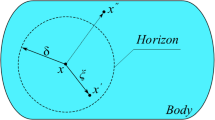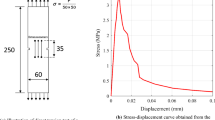Abstract
The non-ordinary state-based peridynamic (NOSB PD) model has the capability of incorporating existing constitutive relationships in the classical continuum mechanics. In the present work, we first develop an NOSB PD model corresponding to the Johnson–Holmquist II (JH-2) constitutive damage model, which can describe the severe damage of concrete under intense impact compression. Besides, the numerical oscillation problem of the NOSB PD caused by zero-energy mode is analyzed and hence a bond-associated non-ordinary state-based peridynamic (BA-NOSB PD) model is adopted to remove the oscillation. Then, the elastic deformation of a three-dimensional bar is analyzed to verify the capability of BA-NOSB PD in eliminating the numerical oscillation. Furthermore, concrete spalling caused by the interaction of incident compression wave and reflected tension wave is simulated. The dynamic tensile fracture process of concrete multiple spalling is accurately reproduced for several examples according to the spalling number and spalling thickness analysis, illustrating the approach can well simulate and analyze the concrete spalling discontinuities.
Graphic Abstract

































Similar content being viewed by others
References
Song, Y., Yan, J., Li, S., et al.: Peridynamic modeling and simulation of ice craters by impact. Comput. Model. Eng. Sci. 121, 465–492 (2019)
Ai, D., Zhao, Y., Wang, Q., et al.: Experimental and numerical investigation of crack propagation and dynamic properties of rock in SHPB indirect tension test. Int. J. Impact Eng 126, 135–146 (2019)
Zhang, Y., Pan, G., Zhang, Y., et al.: A multi-physics peridynamics-DEM-IB-CLBM framework for the prediction of erosive impact of solid particles in viscous fluids. Comput. Methods Appl. Mech. Eng. 352, 675–690 (2019)
Zhou, G., Hillman, M.: A non-ordinary state-based Godunov-peridynamics formulation for strong shocks in solids. Comput. Part. Mech. 7, 365–375 (2020)
Guo, J.S., Gao, W.C.: Study of the Kalthoff-Winkler experiment using an ordinary state-based peridynamic model under low velocity impact. Adv. Mech. Eng. 11, 168781401985256 (2019)
Liu, R., Yan, J., Li, S.: Modeling and simulation of ice–water interactions by coupling peridynamics with updated Lagrangian particle hydrodynamics. Comput. Part. Mech. 7, 241–255 (2020)
Lai, X., Ren, B., Fan, H., et al.: Peridynamics simulations of geomaterial fragmentation by impulse loads. Int. J. Numer. Anal. Meth. Geomech. 39, 1304–1330 (2015)
Lai, X., Liu, L., Li, S., et al.: A non-ordinary state-based peridynamics modeling of fractures in quasi-brittle materials. Int. J. Impact Eng 111, 130–146 (2018)
Silling, S.A., Parks, M.L., Kamm, J.R., et al.: Modeling shockwaves and impact phenomena with Eulerian peridynamics. Int. J. Impact Eng 107, 47–57 (2017)
Gu, X., Zhang, Q., Huang, D., et al.: Wave dispersion analysis and simulation method for concrete SHPB test in peridynamics. Eng. Fract. Mech. 160, 124–137 (2016)
Gu, X., Zhang, Q.: A modified conjugated bond-based peridynamic analysis for impact failure of concrete gravity dam. Meccanica 55, 547–566 (2020)
Chu, B., Liu, Q., Liu, L., et al.: A rate-dependent peridynamic model for the dynamic behavior of ceramic materials. Comput. Model. Eng. Sci. 124, 151–178 (2020)
Shen, F., Yu, Y., Zhang, Q., et al.: Hybrid model of peridynamics and finite element method for static elastic deformation and brittle fracture analysis. Eng. Anal. Bound. Elem. 113, 17–25 (2020)
Wu, L., Huang, D., Xu, Y., et al.: A non-ordinary state-based peridynamic formulation for failure of concrete subjected to impacting loads. Comput. Model. Eng. Sci. 118, 561–581 (2019)
Zhou, X., Wang, Y., Shou, Y., et al.: A novel conjugated bond linear elastic model in bond-based peridynamics for fracture problems under dynamic loads. Eng. Fract. Mech. (2017). https://doi.org/10.1016/j.engfracmech.2017.07.031
Zhou, X., Wang, Y., Qian, Q.: Numerical simulation of crack curving and branching in brittle materials under dynamic loads using the extended non-ordinary state-based peridynamics. Eur. J. Mech. 60, 277–299 (2016)
Silling, S.A.: Stability of peridynamic correspondence material models and their particle discretizations. Comput. Methods Appl. Mech. Eng. 322, 42–57 (2017)
Li, P., Hao, Z.M., Zhen, W.Q.: A stabilized non-ordinary state-based peridynamic model. Comput. Methods Appl. Mech. Eng. 339, 262–280 (2018)
Wan, J., Chen, Z., Chu, X., et al.: Improved method for zero-energy mode suppression in peridynamic correspondence model. Acta. Mech. Sin. 35, 1021–1032 (2019)
Chowdhury, S.R., Roy, P., Roy, D., et al.: A modified peridynamics correspondence principle: removal of zero-energy deformation and other implications. Comput. Methods Appl. Mech. Eng. 346, 530–549 (2019)
Madenci, E., Dorduncu, M., Phan, N., et al.: Weak form of bond-associated non-ordinary state-based peridynamics free of zero energy modes with uniform or non-uniform discretization. Eng. Fract. Mech. 218, 106613 (2019)
Gu, X., Zhang, Q., Madenci, E., et al.: Possible causes of numerical oscillations in non-ordinary state-based peridynamics and a bond-associated higher-order stabilized model. Comput. Methods Appl. Mech. Eng. 357, 112592 (2019)
Yaghoobi, A., Chorzepa, M.G.: Higher-order approximation to suppress the zero-energy mode in non-ordinary state-based peridynamics. Comput. Struct. 188, 63–79 (2017)
Cui, H., Li, C., Zheng, H.: The generation of non-ordinary state-based peridynamics by the weak form of the peridynamic method. Math. Mech. Solids 25, 1544–1567 (2020)
Luo, J., Sundararaghavan, V.: Stress-point method for stabilizing zero-energy modes in non-ordinary state-based peridynamics. Int. J. Solids Struct. 150, 197–207 (2018)
Gu, X., Zhang, Q., Madenci, E.: Non-ordinary state-based peridynamic simulation of elastoplastic deformation and dynamic cracking of polycrystal. Eng. Fract. Mech. 218, 106568 (2019)
Gu, X., Zhang, Q., Yu, Y.: An effective way to control numerical instability of a nonordinary state-based peridynamic elastic model. Math. Probl. Eng. Theory Methods Appl. (2017). https://doi.org/10.1155/2017/1750876
Gu, X., Madenci, E., Zhang, Q.: Revisit of non-ordinary state-based peridynamics. Eng. Fract. Mech. 190, 31–52 (2018)
Li, H., Zheng, Y.G., Zhang, Y.X., et al.: Large deformation and wrinkling analyses of bimodular structures and membranes based on a peridynamic computational framework. Acta. Mech. Sin. 35, 1226–1240 (2019)
Wang, L.: Stress Wave Foundation (In Chinese). National Defense Industry Press, Beijing (2005)
Zhang, L., Hu, S., Chen, D.X., et al.: An experimental technique for spalling of concrete. Exp. Mech. 49, 523–532 (2009)
Hu, S.S., Zhang, L., Wu, H.J., et al.: Experimental study on spalling strength of concrete. Eng. Mech. 21, 128–132 (2004)
Klepaczko, J.R., Brara, A.: An experimental method for dynamic tensile testing of concrete by spalling. Int. J. Impact Eng 25, 387–409 (2001)
Lu, Z., Wang, Z.: Dispersion characteristics of peridynamics method and its application to spalling analysis of rock (in chinese). J. Harbin Inst. Technol. (2016)
Xue, D.: Preliminary Investigation on Spall Fracture (In Chinese). Wuhan University of Technology, Wuhan (2016)
Liao, L.: The Numerical Simulation of Dynamic Indirect Tensile and Spalling Test About Concrete (In Chinese). Hefei University of Technology, Hefei (2016)
Forquin, P., Erzar, B.: Dynamic fragmentation process in concrete under impact and spalling tests. Int. J. Fract. 163, 193–215 (2010)
Khosravani, M.R., Wagner, P., Frohlich, D., et al.: Dynamic fracture investigations of ultra-high performance concrete by spalling tests. Eng. Struct. 201, 109844 (2019)
Piscesa, B., Attard, M.M., Prasetya, D., et al.: Modeling cover spalling behavior in high strength reinforced concrete columns using a plasticity-fracture model. Eng. Struct. 196, 109336 (2019)
Silling, S.A.: Reformulation of elasticity theory for discontinuities and long-range forces. J. Mech. Phys. Solids 48, 175–209 (2000)
Silling, S.A., Epton, M.A., Weckner, O., et al.: Peridynamic states and constitutive modeling. J. Elast. 88, 151–184 (2007)
Madenci, E., Oterkus, E.: Peridynamic theory and its applications to diffusion equation. Peridyn. Theory Appl. (2014). https://doi.org/10.1007/978-1-4614-8465-3
Bobaru, F., Foster, J.T., Geubelle, P.H., et al.: Handbook of Peridynamic Modeling. CRC Press, Boca Raton (2016)
Silling, S.A., Askari, E.: A meshfree method based on the peridynamic model of solid mechanics. Comput. Struct. 83, 1526–1535 (2005)
Warren, T.L., Silling, S.A., Askari, A., et al.: A non-ordinary state-based peridynamic method to model solid material deformation and fracture. Int. J. Solids Struct. 46, 1186–1195 (2009)
Breitenfeld, M.S., Geubelle, P.H., Weckner, O., et al.: Non-ordinary state-based peridynamic analysis of stationary crack problems. Comput. Methods Appl. Mech. Eng. 272, 233–250 (2014)
Chen, H.: Bond-associated deformation gradients for peridynamic correspondence model. Mech. Res. Commun. 90, 34–41 (2018)
Chen, H., Spencer, B.W.: Peridynamic bond-associated correspondence model: stability and convergence properties. Int. J. Numer. Methods Eng. 117, 713–727 (2019)
Foster, J.T., Silling, S.A., Chen, W.: An energy based failure criterion for use with peridynamic states. Int. J. Multiscale Comput. Eng. 9, 675–688 (2015)
Underwood, P.: Dynamic Relaxation; Computational Method for Transient Analysis. North Holland, Amsterdam (1983)
Parks, M.L., Lehoucq, R.B., Plimpton, S.J., et al.: Implementing peridynamics within a molecular dynamics code. Comput. Phys. Commun. 179, 777–783 (2008)
Parks, M.L., Seleson, P., Plimpton, S.J. et al.: Peridynamics with LAMMPS: A User Guide. Version 0.3 Beta (2011)
Johnson, G.R., Holmquist, T.J.: An improved computational constitutive model for brittle materials. AIP Conference Proceedings, pp. 981–984 (1994)
Chen, Z., Bakenhus, D., Bobaru, F.: A constructive peridynamic kernel for elasticity. Comput. Methods Appl. Mech. Eng. 311, 356–373 (2016)
Huang, Z.: Revisiting the peridynamic motion equation due to characterization of boundary conditions. Acta. Mech. Sin. 35, 972–980 (2019)
Gu, X., Zhang, Q., Madenci, E.: Refined bond-based peridynamics for thermal diffusion. Eng. Comput. 36, 2557–2587 (2019)
Hiermaier, S.: Improvements to the Prototype Micro-brittle Model of Peridynamics. Springer, Berlin (2015)
Shojaei, A., Mossaiby, F., Zaccariotto, M., et al.: An adaptive multi-grid peridynamic method for dynamic fracture analysis. Int. J. Mech. Sci. 144, 600–617 (2018)
Gu, X., Zhang, Q., Xia, X.: Voronoi-based peridynamics and cracking analysis with adaptive refinement. Int. J. Numer. Meth. Eng. 112, 2087–2109 (2017)
Wang, G.: Dynamic Response and Damage Mechanism of Concrete Gravity Dams Under Extreme Loadings (In Chinese). Tianjin University, Tianjin (2014)
Chai, C.: Study on the Mechanism of Penetration into Concrete of Nose Headed Projectile (In Chinese). Beijing Institute of Technology, Beijing (2014)
Acknowledgements
This work was financially supported by the Fundamental Research Funds for the Central Universities (Grant B200202231), the National Natural Science Foundation of China (Grants 11932006, 11672101, U1934206, and 12002118), the National Key Research & Development Plan of China (Grants 2018YFC0406703 and 2017YFC1502603), and the China Postdoctoral Science Foundation (Grant 2019M651667).
Author information
Authors and Affiliations
Corresponding author
Additional information
Executive Editor: Jian-Xiang Wang
Rights and permissions
About this article
Cite this article
Yang, S., Gu, X., Zhang, Q. et al. Bond-associated non-ordinary state-based peridynamic model for multiple spalling simulation of concrete. Acta Mech. Sin. 37, 1104–1135 (2021). https://doi.org/10.1007/s10409-021-01055-5
Received:
Revised:
Accepted:
Published:
Issue Date:
DOI: https://doi.org/10.1007/s10409-021-01055-5




